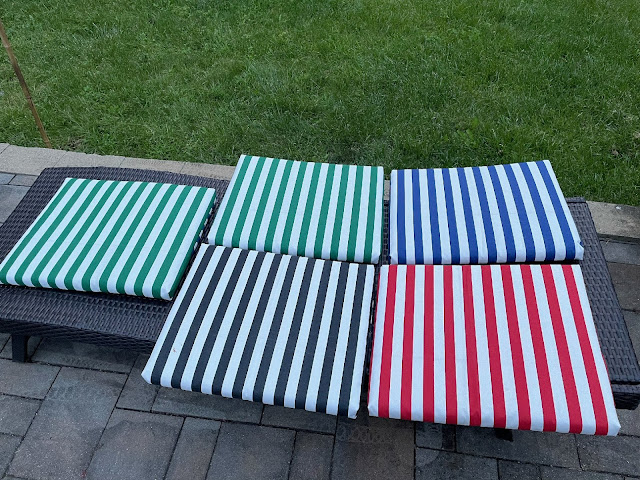
|
|
"Without mathematics there is no art" |
Somewhere in all these blog posts, I've shared the fact that I abandoned art
school after one year – due to being given the impression that there are
rules on how to "make art" – and subsequently ended up with a career in
IT.
Watch live classes for FREE at CreativeLive!

[affiliate link]
Check out crafty classes at Creativebug!

[affiliate link]
In between those events, I pursued a double major at university, with one
of those majors being math. It was a subject that I had excelled at in
high school.
Even though post secondary level mathematics ended up being much more
difficult, I never lost my appreciation for the beauty behind the
art of math. It is a precise, exact and unbending science and yet
can be so organically malleable at the same time. Who would have thought
that, decades later, I would be thankful for being able to apply math to
sewing?
Don't worry, while math is the topic of today's post, it's not going to be
front and center in any "computational" form.... not until the very
end!


Are you someone who wants to ask the pattern designer: how do I change
this to be this high and that wide? A few simple
calculations are usually all that's needed to work it out, and yet for
some people, it's impossible to do.
Obviously, math is integral to sewing, especially for things that are
sewn from "scratch". Pattern designers need to have a certain amount
of mathematical ability in order to do what they do successfully.
Those of you who use patchwork and quilt patterns can appreciate the
effort that goes into figuring out what the various pieces are – and
how they need to be sewn together in a certain order – to get the
desired result.
Remember this? It's a fabric interpretation of iris folding. All forms of folding –
including, of course, origami – are very much based in mathematics.
Projects like this can be quite intricate.

|
| image courtesy of diy HandyMum Lin TV... |
But even at the simplest level, to sew anything of a certain size, you
have to be able to take and translate measurements and understand how
to add seam allowances. And then it's a matter of knowing how best to lay out and cut the fabric so that you don't waste any of it. Sometimes it's easy, like making a
rectangular drawstring bag. Other times it's much harder, like when I cut up
two jackets to make a duffle bag. For that, I had to come up with a plan to turn various
small pieces into bigger pieces before I could even contemplate using
any sort of pattern to make the bag.
So a common problem is that even if you have a pattern to follow and you
intend to make whatever the same size as the pattern calls for, if
your
fabric allotment doesn't match, you have to make do, and making do will often involve math.
Recently, regular reader Marie corresponded with me about
this post back in September. After sharing pics of her customized sewing challenge, I thought the
work she did would be the perfect example to highlight for this blog post.
So I did a quasi "Q&A" with her via email.

|
| Marie's fabulous handiwork... |
First of all, by way of an explanation, her project was to make
some outdoor pillows (and seat cushions) based on a pattern using
striped fabrics. Due to fabric constraints, however, it was not a
straight forward approach, since the stripes needed to be fussy
cut.
Q: Describe the inspiration for this project (as
found at Sew4Home, under the title of Spun Stripes Pillow Trio).

|
| The three designs for the Spun Stripes Pillow Trio by Sew4Home... |
A: This pillow project had three layout designs — each
consisted of four fabric blocks, using three of one color and one of
an alternate color. I used the pieced design for both the front and
back of my pillows instead of having a plain back like the original
project called for.

|
| Both sides of Marie's pillows feature the pieced layouts... |
Q. You said that you had similar fabric as the Sew4Home
samples, but not in the right amounts. What exactly did you have?

|
| Fitting pieces made more difficult by having to match stripes... |
A: I had pieces of this striped fabric (a heavy
sailcloth with some kind of waterproofing that makes water bead on
it) in five colors: one yellow, three red, four blue and black,
and five green. The fabric wasn't one large piece but was already
cut up in approximate 28" x 30" sections. They were all different
sizes and with the stripe design, that changed how many blocks I
could cut from each piece. That's what made this a math problem!!
Q: How would you describe the prep work that you
had to do?

|
| Making it fit... |
A: The task was to fit the pattern pieces on
each fabric to see how many I could get. In each color, the
largest piece gave me three blocks of each design, so I
decided that the yellow would be the accent color and with
nine yellow blocks, that dictated nine pillow tops. So I cut
one set of three-blocks-of-each-design in each color.
Drawing out the color layout designs, and taking a pic of what
could fit on each different color fabric piece helped me plan
before cutting, because I needed four different blocks to make
one pillow top.

Q: Did you end up with a fixed plan, or was it a
fluid, changing process?
Laying them out and sewing drew my attention to the beauty of the
blue and green together, so I switched the pattern design and made
layout A (the predominantly red one in the original Sew4Home
sample pic) with two each blue and green instead of the one and
three design! I made them both the same, but could have switched
one to have the green pointing in — saw that long after it was
sewed and stuffed… otherwise I would have taken it apart and
rearranged it.
.jpg)
|
| The surprising appeal of blue and green... |
Q: I noticed in your photos that this project
encompassed more than just pillows. Tell us about the seat
cushions.

|
| Matching seat cushions... |
A: Before making more pillow tops, I had to plan
for the chair seats. I didn't want to waste even an inch of
fabric, and after days of pondering how to squeeze five seat
cushions out of the least number of fabric squares, I sewed three
fabric pieces together with the stripes of the middle section
going the opposite way: =|||= Then I could squeeze two seat
cushion covers out of each of the three fabric sections. The sizes
of the fabric pieces were all different, so I measured and laid
this out a zillion times until it worked. I labeled each piece
with its measurement and used the smallest fabric pieces so that I
could save the larger pieces to cut more pillow top designs. Each
cushion had a a single pattern on one side and two on the reverse.
The fabric folded over the front of each cushion. The back seam
was hand sewn with invisible stitches.

|
| Seat cushions pieced side... |
Q: Did you run into any hiccups during this "make it fit" project?
A: I learned that the bias cut layout C (the
predominantly gray one in the Sew4Home sample pic) was hardest to
fit on smaller fabric pieces.

|
| The bias cut challenge... |
But I found this task to fit my perfectionist attitude and it
was actually quite fun. Many others might not have enjoyed this
incredible puzzle. I was not in a hurry and it took over five
weeks start to finish for making five seat cushions and eight
pillows (that's sixteen pillow top panels — all different except
for the two blue/green).
Q: We originally connected about this via a post on sustainability.
You've told me that this fabric was in your possession for decades
and that it came to you at no cost. Were there any other recycling
opportunities involved with this project?
A: The seat cushion foam came from my neighbor's garbage: an
old 2" thick camping sleeping mat, covered in ripped up nylon. I
saved this in my shed and ripped off the nylon when I had a use
for it. I cut four seat sections using the long stretch and the
fifth seat was pieces of foam from the extra side cut off. Foam in
pieces can be glued together, but I just basted it and wrapped
each seat with batting which I hand basted on. The batting also
helped hold the foam sections together. It took me numerous
drawings and measurement alterations to squeeze the five seat
cushions out. I have a 3" x 16" foam piece left over to make a
neck brace for sleeping on a plane.
I stuffed the pillows with old and new (Walmart $3.57) pillows
cut in half. It's much cheaper than buying stuffing and it's the
same exact material. I did use invisible zippers in the pillow
tops to make it easier to change the stuffing. (Wawak is my
inexpensive online sewing supply for thread/zippers, etc.)

|
| Some left over... |
But I have three pillow tops and other fabric left over to
make an ottoman! The stuffing will be those large peanut shaped
shipping foam material that I have been saving up for years. It
will be a nice surprise for my son!
ME: How many of you agree that Marie's pillow and cushion project
is just stupendous? When I first saw this project on
Sew4Home, I thought it was awesome. But I knew I would never
attempt it, because I had no need for the pillows, nor – perhaps
most importantly – the fabric to make it work. It's wonderful to
see someone execute it to such perfection!

Of course, you've noticed by now that the title of this post implies a
"part two" is still to come. I have a special tutorial to share with
you in that one, which arose out of this equation:

|
| One of the "fun" ways to calculate phi (courtesy of Erol Karazincir)... |
And just in case you don't find anything fun in the above, let me
reassure you that the project itself is not at all as esoteric!



I understand trying to piece fabric together to make it work. This was impressive and the outcome looks excellent
ReplyDeleteYes, they certainly look like high-end patio decor!
Delete